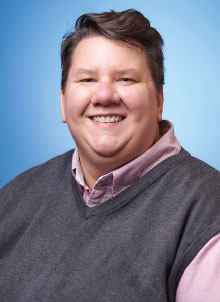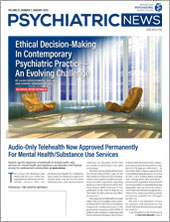If health services researchers don’t ask questions about distinct subpopulations, those populations will be invisible.
That’s one of the important takeaways from a study published last year in the journal LGBT Health by psychiatrist Adrienne Grzenda, M.D., Ph.D., a former APA Health Services Research Fellow and current consultant on bioinformatics and “big data” to the APA Division of Research.
Grzenda’s study showed a dramatic increase in mental health distress among sexual and gender minority individuals associated with the 2016 election of Donald Trump.
The finding has implications for how broad political, social, and cultural currents can sometimes directly impact mental health and distress—a finding that has been picked up by major news outlets including USA Today and television network news.
But Grzenda believes the study also demonstrated the importance of asking the right questions and including in survey research populations that have previously been overlooked—in this case, sexual and gender minority individuals. Grzenda’s co-authors were Haiyong Xu, Ph.D., Jeanne Miranda, Ph.D., and Susan Ettner, Ph.D., all of the University of California, Los Angeles (UCLA).
“It is only recently that large health surveys like the CDC’s Behavioral Risk Factor Surveillance System [BRFSS] have even started to ask questions about sexual orientation and gender identity,” Grzenda told Psychiatric News. “It’s gratifying to me that one of the things this study has brought out is the importance of representation in the data. It is unacceptable to have minority segments of the population known to receive disparate care remain hidden in health care and health survey data.”
She began the research that resulted in the August 2021 study during her two years as the first APA Health Services Research Fellow while in her third and fourth years of residency at UCLA. She is now on the faculty of the David Geffen School of Medicine at UCLA and the UCLA-Olive View Medical Center. The two-year fellowship began in 2017.
Grzenda brought to this investigation a remarkable resume—she received her M.D. and Ph.D. (in biochemistry and molecular biology, studying epigenomics) from the Mayo Clinic and a master’s of science in bioinformatics and computational biology from the University of Minnesota. She completed her residency in the UCLA-Semel Institute research track and is board certified in psychiatry and clinical informatics.
She has applied this formidable background to the study of the mental health of LGBT populations. “When I applied for the APA fellowship, my proposal was to investigate gender minority mental health using underexplored data types, such as insurance claims and data from social media—for instance, looking at suicide narratives of transgender and nonbinary individuals in social media posts,” Grzenda said.
“We know that there is a gap in mental health services for LGBT populations and that the lifetime rate of suicide attempt among transgender and nonbinary individuals has persisted at around 40%,” she said. “How do we better capture information about gender minority mental health and distress to provide better service?”
In the study, she and her colleagues used cross-sectional data from the 17 states that administered the sexual orientation and gender identity module in the 2015 and 2018 BRFSS surveys. The sample included 268,851 adult respondents: 12,006 sexual and gender minority adults and 256,845 cisgender and heterosexual adults.
The primary outcome was reported physical distress, mental distress, limited activity, and/or fair or poor general health for 14 days or more in the previous month.
Grzenda noted that in the run-up to the election, Trump and running mate Mike Pence spoke prominently about overturning some of the LGBT protections enacted during the Obama presidency. Following the election, she and her colleagues noted in the study, 129 bills were proposed during the 2017 legislative season in 30 states, targeting LGBT and gender minority protections ranging from housing to health care to adoption.
“Our hypothesis was that we should be able to use this large representative sample [the BRFSS] to empirically test if there was an increase in LGBT mental distress in relation to the election,” she said.
She emphasized that a survey asking people whether the election caused distress would elicit a lot of biased answers. But the BRFSS is a “cold call” telephone survey that includes general questions about health and mental health.
Merely comparing pre-election and post-election changes in mental distress could be misleading as other factors besides the election could be responsible. So Grzenda and colleagues employed a quasi-experimental approach known as “difference-in-differences” to calculate the impact of an event (in this case the 2016 election of Donald Trump).
By comparing changes in the outcome (mental distress) in a “treatment” group affected by the event to a “control” group, unaffected by the event, the design better controls for unseen confounding factors.
“In this way, difference-in-differences allows you to make some causal inferences,” she explained. Analysis of the data also controlled for sociodemographic variables, health care coverage, and chronic medical conditions.
They found that the LGBT population as a whole experienced a statistically significant increase in frequent mental distress compared with that of the cisgender and heterosexual sample—but that the gender minority group (transgender and nonbinary individuals) experienced a dramatic increase.
Compared with the cisgender and heterosexual population, the cisgender and lesbian and gay populations experienced an increase in the primary outcome of 1.5% points, an 11.6% relative increase from 2015, although this was not statistically significant. The cisgender and bisexual or other respondents experienced a 4.8% point increase relative to the cisgender and heterosexual population, a 27.6% increase from 2015.
However, the transgender or gender-nonconforming population experienced a 14.8% point increase relative to the cisgender and heterosexual population—a startling 117.5% relative increase from 2015.
“Prior studies indicate that gender minority and bisexual individuals often experience greater vulnerability to poor mental and health outcomes,” Grzenda and colleagues wrote. “Existing disparities may then sensitize these subgroups to the effects of acute or compounded stress. The overwhelming majority of anti-LGBT legislation proposed during the time period examined specifically targeted the rights of gender minority individuals. ... The effect on subgroups may then be dose dependent, with the increases in mental distress proportionate to the extent to which the individual perceives impact.”
Today, Grzenda is using her expertise in data science to help the APA Division of Research as it explores how large population datasets can be used to improve the mental health of individuals and communities.
“Big data is the next evolution in health services research,” she said. “How can we leverage ever-proliferating health data with machine learning and other artificial intelligence techniques toward improved outcomes for patients?” ■
“Impact of the 2016 Election on the Quality of Life of Sexual and Gender Minority Adults: A Difference-in-Differences Analysis” is posted
here.

